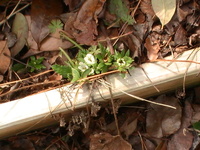Search
Latest topics
» N & C Midwest: Nov. Dec. 2024by Scorpio Rising Today at 8:23 pm
» Butterbaby Hybrid Squash (Butternut)
by Scorpio Rising Today at 8:19 pm
» Indoor Lighting for Kitchen Herbs & Lettuce
by OhioGardener 11/22/2024, 6:58 pm
» Catalog season has begun!
by OhioGardener 11/22/2024, 3:35 pm
» Happy Birthday!!
by AtlantaMarie 11/22/2024, 4:13 am
» Interesting Marketing for Compost
by OhioGardener 11/21/2024, 7:29 pm
» How does green turn to brown?
by OhioGardener 11/21/2024, 4:58 pm
» Ohio Gardener's Greenhouse
by OhioGardener 11/21/2024, 12:16 pm
» Tree roots, yeeessss.....
by sanderson 11/20/2024, 2:21 am
» The SFG Journey-Biowash
by has55 11/19/2024, 7:37 pm
» What are you eating from your garden today?
by OhioGardener 11/19/2024, 8:27 am
» Cooked worms?
by KiwiSFGnewbie 11/19/2024, 1:04 am
» New SFG gardener in Auckland
by KiwiSFGnewbie 11/16/2024, 11:25 pm
» Kiwi's SFG Adventure
by KiwiSFGnewbie 11/12/2024, 7:10 pm
» Thanksgiving Cactus
by OhioGardener 11/12/2024, 5:40 pm
» Need Garden Layout Feedback
by markqz 11/9/2024, 9:16 pm
» Thai Basil
by Scorpio Rising 11/8/2024, 8:52 pm
» How best to keep a fallow SFG bed
by KiwiSFGnewbie 11/8/2024, 8:11 pm
» Preserving A Bumper Tomato Harvest with Freezing vs Canning
by plantoid 11/7/2024, 11:36 am
» Mark's first SFG
by sanderson 11/6/2024, 11:51 pm
» What Have You Picked From Your Garden Today
by OhioGardener 11/5/2024, 2:29 pm
» Greetings from Southeastern Wisconsin
by sanderson 11/5/2024, 2:01 pm
» Spinning Compost Bin-need some ideas
by rtfm 11/2/2024, 7:49 pm
» Growing fruit trees in Auckland
by OhioGardener 10/31/2024, 4:23 pm
» Vermiculite -- shipping sale through 10/31/2024
by markqz 10/30/2024, 2:27 pm
» N & C Midwest: October 2024
by Scorpio Rising 10/30/2024, 10:38 am
» Old Mulch and Closing Beds for Winter
by sanderson 10/26/2024, 11:00 pm
» Hello from Land of Umpqua, Oregon Zone 8b
by sanderson 10/25/2024, 3:14 pm
» Hello everyone!
by SFGHQSTAFF 10/24/2024, 3:22 pm
» Senior Gardeners
by sanderson 10/23/2024, 6:09 pm
Google
Crop rotation
+70
yolos
boffer
camprn
mapspringer
lzalvis
FamilyGardening
WriterCPA
Hoggar
edfhinton
Tris
CapeCoddess
didomach
CindiLou
Hardcoir
H_TX_2
Bud Alexis
bnoles
Rustic Patriot
Lemonie
LivingTheDream
Cincinnati
Pollinator
JeanneRamick
cheyannarach
Kelejan
Turan
gwennifer
quiltbea
llama momma
johnp
cpl100
Triciasgarden
Carleen
GWN
AvaDGardner
AppleofGODseye
sfg4uKim
sherryeo
RoOsTeR
southern gardener
Feistywidget
littlesapphire
littlejo
middlemamma
Chopper
AprilakaCCIL
shannon1
DevinGoulding
Barkie
staf74
tabletopper
ModernDayBetty
Mamachibi
happycamper
BackyardBirdGardner
clfraser
Ray'ssfg
jenjehle
pattipan
SFG in Chicago
GloriaG
Bec
Odd Duck
ander217
Garden Angel
Megan
organicgardeningzen.com
Kabaju42
mckr3441
dschenko
74 posters
Page 3 of 6
Page 3 of 6 •  1, 2, 3, 4, 5, 6
1, 2, 3, 4, 5, 6 
 Re: Crop rotation
Re: Crop rotation
I'm having to do a sort of crop rotation. First, I messed up and wanted lots of crops, enough to freeze/can, so, I made several beds and planted numerous sqs. of each item. I planted 1/2 bed with sqs of green beans. I got nematodes which came up from the ground and into the MM. Nematodes love MM. I've been told not to plant green beans in that bed for at least 2 seasons. I have to plant French Marigolds in that bed, grow for 2 months, then turn under. I will be planting F. marigolds in all beds in between the sqs. for my ground has nematodes. I will at least have a pretty garden!
Jo
Jo

littlejo-
 Posts : 1573
Posts : 1573
Join date : 2011-05-04
Age : 71
Location : Cottageville SC 8b
 Re: Crop rotation
Re: Crop rotation
I plan on doing a little bit of crop rotation, partly because I'm afraid of bugs and disease finding my plants, and partly because I'm curious if certain plants do better in certain spots. Since some of my boxes are in more shade or better wind protection than others, I want to see which plant likes which spot the best. So far I've found the best spot for my squash!
 crop rotation in SFG?
crop rotation in SFG?
I know with traditional row gardening method, you do crop rotation so you don't get pests and to avoid plant diseases, etc.
I'm wondering if this is something you have to do with SFG boxes and if so how often? Basically is it something mandatory with SFG? If it's going to create healthier plants and be beneficial for your SFG, fine. However if it doesn't matter either way, then please let me know. Either way (yes it's mandatory, no it doesn't make any difference) please provide clarification with this.
Every season? By season.....is it the actual season (rotating every spring, summer, winter, fall) or does season mean you rotate at the start of every new year whenever the new season starts in your area?
I'm wondering if this is something you have to do with SFG boxes and if so how often? Basically is it something mandatory with SFG? If it's going to create healthier plants and be beneficial for your SFG, fine. However if it doesn't matter either way, then please let me know. Either way (yes it's mandatory, no it doesn't make any difference) please provide clarification with this.
Every season? By season.....is it the actual season (rotating every spring, summer, winter, fall) or does season mean you rotate at the start of every new year whenever the new season starts in your area?

Feistywidget- Posts : 38
Join date : 2011-10-01
Location : Boyne City Michigan (gardening zone 5; short growing season....mild and cool climate...hot summers, but much milder than summers in tropical gardening zones)
 Re: Crop rotation
Re: Crop rotation
I rotate crops to different boxes each year.
43 years a gardener and going strong with SFG.
https://squarefoot.forumotion.com/t3574-the-end-of-july-7-weeks-until-frost
There are certain pursuits which, if not wholly poetic and true, do at least suggest a nobler and finer relation to nature than we know. The keeping of bees, for instance. ~ Henry David Thoreau
https://squarefoot.forumotion.com/t1306-other-gardening-books
 Re: Crop rotation
Re: Crop rotation
with ours, it sort of naturally rotates. When we empty a square, we add the compost and just planted a different plant/seed in the square. Really nothing to think about, it just sort of happens.

southern gardener- Posts : 1883
Join date : 2011-06-21
Age : 44
Location : california, zone 10a
 Re: Crop rotation
Re: Crop rotation
southern gardener wrote:with ours, it sort of naturally rotates. When we empty a square, we add the compost and just planted a different plant/seed in the square. Really nothing to think about, it just sort of happens.
And that's pretty much the basic idea stated in the book.
fiesty, check out page 144 for a bit more on crop rotation. Not as critical as row gardening, but still very much suggested.

RoOsTeR-
 Posts : 4299
Posts : 4299
Join date : 2011-10-04
Location : Colorado Front Range
 Re: Crop rotation
Re: Crop rotation
Um a very stupid question, but here goes anyway. According to the ppl on this forum since you're using 5 different kinds of fertilizer (which is minimum, according to them you could possibly add more) it provides all the nutrients the plant needs.
So if that's the case, why do you have to add compost when you replant?
So if that's the case, why do you have to add compost when you replant?

Feistywidget- Posts : 38
Join date : 2011-10-01
Location : Boyne City Michigan (gardening zone 5; short growing season....mild and cool climate...hot summers, but much milder than summers in tropical gardening zones)
 Re: Crop rotation
Re: Crop rotation
The recipe does not call for fertilizer but 5 different types of compost. I think of the compost as building tilth and nutrition and health to the growing medium, not just adding chemicals, tho those would do the job, sorta...
By adding compost after harvest and before growing something new, it feeds the growing medium, so it in turn will feed the plant so that it in turn will feed me.
And I think it was a very good question!
By adding compost after harvest and before growing something new, it feeds the growing medium, so it in turn will feed the plant so that it in turn will feed me.
And I think it was a very good question!
43 years a gardener and going strong with SFG.
https://squarefoot.forumotion.com/t3574-the-end-of-july-7-weeks-until-frost
There are certain pursuits which, if not wholly poetic and true, do at least suggest a nobler and finer relation to nature than we know. The keeping of bees, for instance. ~ Henry David Thoreau
https://squarefoot.forumotion.com/t1306-other-gardening-books
 Re: Crop rotation
Re: Crop rotation
In other words, the plants use the nutrients in the compost, so you have to replenish it with more, especially at the point where you're ready to plant more veggies in the same squares.

sherryeo-
 Posts : 848
Posts : 848
Join date : 2011-04-03
Age : 72
Location : Mississippi Gulf Coast Zone 8B
 Re: Crop rotation
Re: Crop rotation
Feisty, I think you would really enjoy the book - it covers the two areas you asked about.
I wouldn't use the word "mandatory", instead crop rotation is automatic because you re-use each square up to 3 times a year (spring, summer & fall crops) depending on how long from planting until harvest.
No matter WHAT method you choose, you should ALWAYS rotate members of the nightshade family and not replant tomatoes, eggplant, etc. in the same square(s) for three years.
Because SFG is such an INTENSIVE method, it takes the nutrients out of the soil more quickly than other methods - thus the reason you will want to add a trowel-full of compost when you harvest a square.
The main areas Mel feels should be strictly adhered to have to do with a wide variety of composts in your mix, thoroughly watering every 2" as you add your Mel's Mix to the raised bed and the grid. He has found that when people don't follow his suggestions, they tend to blame the METHOD instead of the fact that they are not following the method.
Welcome to the Forum.
I wouldn't use the word "mandatory", instead crop rotation is automatic because you re-use each square up to 3 times a year (spring, summer & fall crops) depending on how long from planting until harvest.
No matter WHAT method you choose, you should ALWAYS rotate members of the nightshade family and not replant tomatoes, eggplant, etc. in the same square(s) for three years.
Because SFG is such an INTENSIVE method, it takes the nutrients out of the soil more quickly than other methods - thus the reason you will want to add a trowel-full of compost when you harvest a square.
The main areas Mel feels should be strictly adhered to have to do with a wide variety of composts in your mix, thoroughly watering every 2" as you add your Mel's Mix to the raised bed and the grid. He has found that when people don't follow his suggestions, they tend to blame the METHOD instead of the fact that they are not following the method.
Welcome to the Forum.
I have seen women looking at jewelry ads with a misty eye and one hand resting on the heart, and I only know what they're feeling because that's how I read the seed catalogs in January - Barbara Kingsolver - Animal, Vegetable, Miracle
sfg4u.com
FB: Square Foot Gardening 4 U

FB: Square Foot Gardening 4 U
 Crop Rotation
Crop Rotation
We know you are not supose to replant the same plant in the same spot every season, but we don't know what to follow the different plants with.
Is there someplace that tells us how to rotate the crops?
If we should put roots after leaf or leaf after root, etc.
Does it matter?
Is there someplace that tells us how to rotate the crops?
If we should put roots after leaf or leaf after root, etc.
Does it matter?

AppleofGODseye- Posts : 1
Join date : 2010-04-16
 Crop Rotation
Crop Rotation
I know opinions vary on this, but I believe that the best crop rotation is to follow each crop with ones that consecutively use a different major soil nutrient so that the soil can have time to rest and regenerate before having to support the same crop needs again. i.e.
Always add your regular scoop of compost before you plant each crop. Then start with:
LEAF CROPS which use nitrogen such as - Lettuce, mesclun greens, herbs, cabbage, kale, broccoli, cauliflower, spinach, etc. follow them with:
FRUIT CROPS which use phosphorus such as - Tomatoes, cucumbers, squash, peppers, eggplant, etc. follow these with:
ROOT CROPS which use potassium such as - radish, carrots, turnips, beets, onions, leeks, etc. followed by:
LEGUMES which either don't require soil nitrogen or add small amounts of it back to the soil such as - Peas, beans, and potatoes (because they are not nitrogen users)
Then start over - that provides a rotation of four separate crops that all use different nutrients from the soil.
But keep in mind that the scoop of compost you add to the MM should have all the nutrients your plants need.
Always add your regular scoop of compost before you plant each crop. Then start with:
LEAF CROPS which use nitrogen such as - Lettuce, mesclun greens, herbs, cabbage, kale, broccoli, cauliflower, spinach, etc. follow them with:
FRUIT CROPS which use phosphorus such as - Tomatoes, cucumbers, squash, peppers, eggplant, etc. follow these with:
ROOT CROPS which use potassium such as - radish, carrots, turnips, beets, onions, leeks, etc. followed by:
LEGUMES which either don't require soil nitrogen or add small amounts of it back to the soil such as - Peas, beans, and potatoes (because they are not nitrogen users)
Then start over - that provides a rotation of four separate crops that all use different nutrients from the soil.
But keep in mind that the scoop of compost you add to the MM should have all the nutrients your plants need.
 Re: Crop rotation
Re: Crop rotation
Thanks for asking this question, and the understandable list!
This is something I've puzzled over A LOT. Especially when you have permenant structures attached to your boxes for certain types of plants. It makes rotation thoughts more difficult.
I also appreciate the info that "fruits" means more than just obvious fruits like "berries." I'd never thought of it that way.
But then, you run into what to do with your perennial plants. For me, that's strawberries. They are rather like spider plants - one established with off shoot babies. And you get more production from established plants. So how do you rotate them?
I also puzzle over how to add phosphorus. It's the one thing I'm consistently low on. Since everything is pretty much planted now, I'm wondering if there is a liquid something I can add to feed but not disturb the plants.
This is something I've puzzled over A LOT. Especially when you have permenant structures attached to your boxes for certain types of plants. It makes rotation thoughts more difficult.
I also appreciate the info that "fruits" means more than just obvious fruits like "berries." I'd never thought of it that way.
But then, you run into what to do with your perennial plants. For me, that's strawberries. They are rather like spider plants - one established with off shoot babies. And you get more production from established plants. So how do you rotate them?
I also puzzle over how to add phosphorus. It's the one thing I'm consistently low on. Since everything is pretty much planted now, I'm wondering if there is a liquid something I can add to feed but not disturb the plants.

AvaDGardner-
 Posts : 634
Posts : 634
Join date : 2012-02-17
Location : Garden Grove, CA (still Zone 10b)
 Crop Rotation
Crop Rotation
Perennial plants don't need to be rotated -only amended with compost when you do your "spring-cleaning".
Phosphorus can be increased by adding Bonemeal.
Phosphorus can be increased by adding Bonemeal.
 Re: Crop rotation
Re: Crop rotation
A very light sprinkling of wood ash would add a bit of phosphorus to the soil; Do not add too much as it will adjust the soil pH.
43 years a gardener and going strong with SFG.
https://squarefoot.forumotion.com/t3574-the-end-of-july-7-weeks-until-frost
There are certain pursuits which, if not wholly poetic and true, do at least suggest a nobler and finer relation to nature than we know. The keeping of bees, for instance. ~ Henry David Thoreau
https://squarefoot.forumotion.com/t1306-other-gardening-books
 Re: Crop rotation
Re: Crop rotation
For strawberries, mulch with pine straw, for they like high acidity as do tomatoes and potatoes.

littlejo-
 Posts : 1573
Posts : 1573
Join date : 2011-05-04
Age : 71
Location : Cottageville SC 8b
 Re: Crop rotation
Re: Crop rotation
I would LOVE to have pine mulch. It would add much needed acid to our soil. I can't find it at the stores...is the only left pet stores? I'm concerned it would be overpriced there.
Camp, does wood ash adjust pH to acid or alkaline? Not that I have any...
Camp, does wood ash adjust pH to acid or alkaline? Not that I have any...

AvaDGardner-
 Posts : 634
Posts : 634
Join date : 2012-02-17
Location : Garden Grove, CA (still Zone 10b)
 Re: Crop rotation
Re: Crop rotation
Wood Ash is said to 'sweeten the soil', makes it less acid. It also contains trace elements beneficial to growing plants.
43 years a gardener and going strong with SFG.
https://squarefoot.forumotion.com/t3574-the-end-of-july-7-weeks-until-frost
There are certain pursuits which, if not wholly poetic and true, do at least suggest a nobler and finer relation to nature than we know. The keeping of bees, for instance. ~ Henry David Thoreau
https://squarefoot.forumotion.com/t1306-other-gardening-books
 Re: Crop rotation
Re: Crop rotation
AvaDGardner wrote:I would LOVE to have pine mulch. It would add much needed acid to our soil. I can't find it at the stores...is the only left pet stores? I'm concerned it would be overpriced there.
Camp, does wood ash adjust pH to acid or alkaline? NYou mightot that I have any...
You might try a farmers market or a store that sells feed. If they don't sell pine straw, they will know who does. Also check big box garden centers or places that sell mulch. Shouldn't be too expensive. Jo
Last edited by littlejo on 4/9/2012, 11:18 pm; edited 1 time in total (Reason for editing : formatting gone wrong!)

littlejo-
 Posts : 1573
Posts : 1573
Join date : 2011-05-04
Age : 71
Location : Cottageville SC 8b
 Re: Crop rotation
Re: Crop rotation
I believe that it adds potassium to the soil.
Which some crops find beneficial, such as potatoes
Which some crops find beneficial, such as potatoes

GWN- Posts : 2799
Join date : 2012-01-14
Age : 68
Location : british columbia zone 5a
 Crop Rotation cheat sheet
Crop Rotation cheat sheet
Penn State has a PDF of crop rotation; I found another great list at dannylipford.com

Carleen-
 Posts : 4
Posts : 4
Join date : 2012-04-09
Age : 51
Location : Mandan, ND Zone 4
 Re: Crop rotation
Re: Crop rotation
AppleofGODseye wrote:We know you are not supose to replant the same plant in the same spot every season, but we don't know what to follow the different plants with.
Is there someplace that tells us how to rotate the crops?
If we should put roots after leaf or leaf after root, etc.
Does it matter?
There are a lot of good answers here, but one of the advantages of this method is crop rotating takes care of itself, especially if you have a spring and/or fall garden. The one thing I watch out for the most is tomatoes and try to mix it up as far as where I plant them. So far it has been easy because I keep moving. LOL. But since you are replacing nutrients with compost each change of square, you needn't stress over it too much. You are not committing a whole 40 acres to one crop that is going to forever become a nematode scourge or anything like that.
 Re: Crop rotation
Re: Crop rotation
I like this, has enough structure and logic.GloriaG wrote:I know opinions vary on this, but I believe that the best crop rotation is to follow each crop with ones that consecutively use a different major soil nutrient so that the soil can have time to rest and regenerate before having to support the same crop needs again. i.e.
Always add your regular scoop of compost before you plant each crop. Then start with:
LEAF CROPS which use nitrogen such as - Lettuce, mesclun greens, herbs, cabbage, kale, broccoli, cauliflower, spinach, etc. follow them with:
FRUIT CROPS which use phosphorus such as - Tomatoes, cucumbers, squash, peppers, eggplant, etc. follow these with:
ROOT CROPS which use potassium such as - radish, carrots, turnips, beets, onions, leeks, etc. followed by:
LEGUMES which either don't require soil nitrogen or add small amounts of it back to the soil such as - Peas, beans, and potatoes (because they are not nitrogen users)
Then start over - that provides a rotation of four separate crops that all use different nutrients from the soil.
But keep in mind that the scoop of compost you add to the MM should have all the nutrients your plants need.
I have just rolled by the seat of my pants, trying to never follow same with same. The first SFG book talks about that by doing things in squares you make it easy to follow one planting with something different and thus result in rotation happening though unplanned. I find htat works great with leafy greens and roots like beets and carrots but the trouble comes with peas and nightshade family(tomato, eggplant, peppers, potato) and unruly vines like winter squash. Those really do best in certain spots in hte garden.

Turan-
 Posts : 2618
Posts : 2618
Join date : 2012-03-29
Location : Gallatin Valley, Montana, Intermountain zone 4
 Re: Crop rotation
Re: Crop rotation
I googled the Penn State article, only to realize it can vary by crop, and by geographic area. Then I did a search for California. The first hit was Farmer Fred Rant, a site I found before regarding a different subject.Chopper wrote:There are a lot of good answers here, but one of the advantages of this method is crop rotating takes care of itself, especially if you have a spring and/or fall garden. The one thing I watch out for the most is tomatoes and try to mix it up as far as where I plant them. So far it has been easy because I keep moving. LOL. But since you are replacing nutrients with compost each change of square, you needn't stress over it too much. You are not committing a whole 40 acres to one crop that is going to forever become a nematode scourge or anything like that.
Chopper, you might find this interesting: http://farmerfredrant.blogspot.com/2010/08/its-crop-rotation-time-do-you-have-room.html. He has a pie chart for the rotation.
If you like scotch, one of his posts for Dec 2010 was a review of them all! HA!

AvaDGardner-
 Posts : 634
Posts : 634
Join date : 2012-02-17
Location : Garden Grove, CA (still Zone 10b)
 Re: Crop rotation
Re: Crop rotation
I try to keep my rotation as close to Eliot Coleman's plan as I can. He's a very successful Organic gardener. He, too, is a northeast gardener like me and also a respected garden book (Four-Season Harvest) author.
Sweet Corn (chop up the stalks and bury them in the soil), followed next time by:
Potatoes, next come
Peas (plant cover crop in fall, like oats, if you can), next come
Brassicas: Broccoli, Brussels sprouts, Cabbage, Cauliflower, Turnip, Radishes, next
Tomatoes, Peppers and Eggplant, next
Cukes, Squash, Melons, Zucchini, Pumpkin, next
Root Crops and Salad Crops: Lettuce, Carrots, Parsnips, Onions, Garlic, Spinach, Swiss Chard, followed by
Beans,
Then start all over again.
With a SFG and different crops in each square, it means lots of planning ahead for the coming year, but its such fun for a winter project. If I don't put in a crop, I just skip to the next one on the list, like sweet corn to peas if no potatoes scheduled. It's not a strict plan but it means less depletion of soil needs for the next crop.
Sweet Corn (chop up the stalks and bury them in the soil), followed next time by:
Potatoes, next come
Peas (plant cover crop in fall, like oats, if you can), next come
Brassicas: Broccoli, Brussels sprouts, Cabbage, Cauliflower, Turnip, Radishes, next
Tomatoes, Peppers and Eggplant, next
Cukes, Squash, Melons, Zucchini, Pumpkin, next
Root Crops and Salad Crops: Lettuce, Carrots, Parsnips, Onions, Garlic, Spinach, Swiss Chard, followed by
Beans,
Then start all over again.
With a SFG and different crops in each square, it means lots of planning ahead for the coming year, but its such fun for a winter project. If I don't put in a crop, I just skip to the next one on the list, like sweet corn to peas if no potatoes scheduled. It's not a strict plan but it means less depletion of soil needs for the next crop.

quiltbea-
 Posts : 4707
Posts : 4707
Join date : 2010-03-21
Age : 82
Location : Southwestern Maine Zone 5A
Page 3 of 6 •  1, 2, 3, 4, 5, 6
1, 2, 3, 4, 5, 6 
 Similar topics
Similar topics» Importance of crop rotation?
» How crucial is crop rotation?
» "Table Top" SFG considerations
» Planning garden to allow for crop rotation
» Crop Rotation Involving Nightshades
» How crucial is crop rotation?
» "Table Top" SFG considerations
» Planning garden to allow for crop rotation
» Crop Rotation Involving Nightshades
Page 3 of 6
Permissions in this forum:
You cannot reply to topics in this forum








